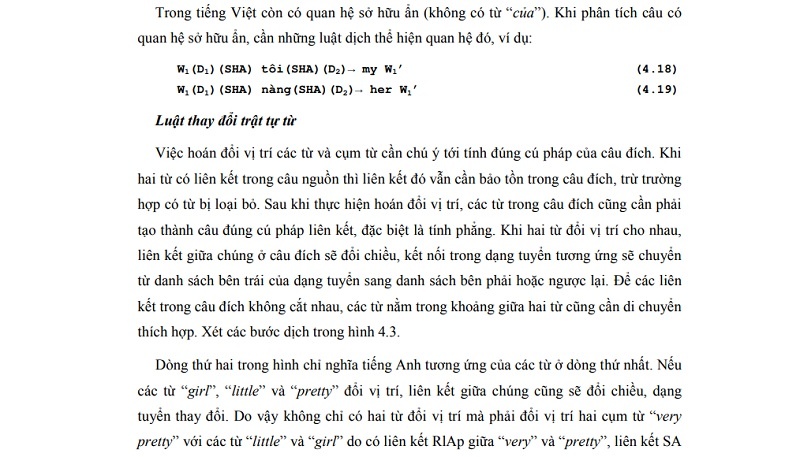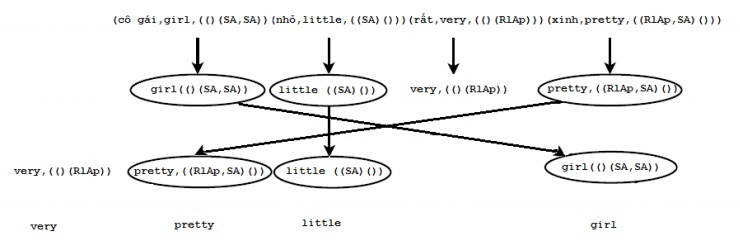Law of phrase translation
Translate phrases into English pronouns

Vocabulary in Vietnamese is very complicated. Even dictionaries have differing views on the wording of the terms of a vocative nature. For example, “we”, “we” appear as a pronoun, but the objects that have the same meaning as “we”, “we” with most dictionaries are considered as two-part phrases. are from. All spoken words are only translated into English as “we”. Likewise, “she” is always considered to be a phrase consisting of the noun “she” and the demonstrative pronoun “she”, “ta”, or the noun “she”. The relationship of the word “she” through the link NtPd+ and SV+ allows translating “she” into “she” , while NtPd+ and O- or EpNt allows translating “she” into “her”:
cô(D1)(NtPd,SV) W2(NtPd)(D2) → she W2’ (4.11)
W1(D1)(EpNt) cô(EpNt)(NtPd) W2(NtPd)(D2) → W1’ her (4.12)
Then, of course, rules are also needed to assign persona information to the corresponding verb. Obviously word-by-word translation is not possible for high-quality translations because in any language there are phrases that, when taken apart, make no sense or have a different meaning. For idiomatic phrases, an idiom dictionary should be used. The rule is only established for phrases with a specific structure commonly used in Vietnamese.
Phrases with the word “go”
The word “go” plays a rather special role when translating Vietnamese – English. In Vietnamese, the word “go” can be combined with some regular verbs, such as “go swimming”, “go shopping”, “go to school”, “go out”. This phenomenon has been shown in the dictionary associating with the DI link for the verb “go” and some other verbs. In many cases, the translation formula will be go + verb + ing (go swimming, go fishing…)
đi(D1)(DI) W2(DI)(D2) →
go W2’(form = PRESENT_PARTICIPLE) (4.13)
Maybe you are interested!
-
 Development Situation Of Machine Translation In Vietnam
Development Situation Of Machine Translation In Vietnam -
 Language Difference Between Vietnamese And English
Language Difference Between Vietnamese And English -
 The Machine Translation System Uses Annotated Selections
The Machine Translation System Uses Annotated Selections -
 Test Results With Annotated Selection-Based Translator
Test Results With Annotated Selection-Based Translator -
 Vietnamese linking grammar model - 28
Vietnamese linking grammar model - 28 -
 Vietnamese linking grammar model - 29
Vietnamese linking grammar model - 29
Some exceptions: “đi học” –> “go to school”, “đi chơi”–>“go out”, “đi ngủ” –> “go to bed” đã được thể hiện qua những luật dịch riêng:
đi(D1)(DI) học(DI)(D2) → go to schooln
đi(D1)(DI) làm(DI)(D2) → go to workn
Law on translation of ownership relations
The possessive relationship in Vietnamese can be clear through the preposition “of” (sometimes the noun “house”, for example “my pig”). The translation rules will change pronouns after the preposition “of” to possessive adjectives, nouns to possessive manner.
Eg
của()(EoPp) tôi(EoPp)() → my (4.16)
của ()(EoPp) anh(EoPp)() → his (4.17)
In Vietnamese, there is also an implicit possessive relationship (there is no word “of”). When analyzing sentences with implicit possessive relations, translation rules that express that relationship are needed, for example:
W1(D1)(SHA) tôi(SHA)(D2)→ my W1’ (4.18)
W1(D1)(SHA) nàng(SHA)(D2)→ her W1’ (4.19)
Law of changing word order
The swapping of words and phrases should pay attention to the syntactic correctness of the target sentence. When two words are linked in the source sentence, the link still needs to be preserved in the target sentence, unless the word is removed. After performing the position swap, the words in the target sentence also need to form a sentence with correct linking syntax, especially flatness. When two words change positions, the link between them in the target sentence will change direction, the connection in the corresponding adjective form will move from the list on the left of the form to the list on the right or vice versa. In order for the links in the target sentence not to intersect, the words between the two words also need to move appropriately. Consider the translation steps in Figure 4.3.
The second line in the figure shows the corresponding English meanings of the words in the first line. If the words “girl”, “little” and “pretty” change positions, the association between them will also change direction, the form changes. Therefore, not only two words changed positions, but also two phrases “very pretty” with the words “little” and “girl” had to be replaced because of the RlAp link between “very” and “pretty”, the SA link between the two words. “girl” with “little” and “pretty”. The displacement does not affect the flatness of the analysis so we get the final result in the 3rd line.

Figure 4.3. Change the word order for the translation of the sentence “The little girl is very pretty”
The law of changing the position of nouns – adjectives
Here are some rules that allow changing the position between an adjective that modifies a noun and an adjective that modifies another adjective. In Vietnamese, there are usually only 2 adjectives that modify a noun (not separated by commas).
W1(D1)(ApAp) W2(ApAp)(D2) → W2’ W1’ (4.20)
W1(D1)(SA SA) W2(SA)(D2) W3(SA)() → W3’ W2’ W1’ (4.21)
W1(D1)(SA) W2(SA)(D2) → W2’ W1’ (4.22)
The law of negative structure translation
The words indicating the negative structure are the negative auxiliary words “no”, “no”, “not yet”… (the word type is Rn). The connection between this type of word and the verb is RnV. When translating this structure, attention should be paid to the conjugation that matches the tense of the verb in the source sentence (the word “not” corresponds to the present perfect, other words translate into the present tense:
W1(D1)(SV) chưa(D2)(RnV) W3(RnV SV)(D3) ->
W1’(D1’)(D2’) have(number = W3. number, person = W3. person)v
(N PP) not(N)(D3’) W3’(negative = FALSE)(PP)(D4’) (4.23)
The Law of Translating Question Structures
In Vietnamese, there are a number of question words (phrases) such as “why”, “when”, etc. The question word can be at the beginning or the end of the sentence. Identify this structure through connecting THT (question word at the beginning of a sentence) or THS (question word at the end of a sentence). When translating into English with regular verbs (not the verb “to be”), it is necessary to add an auxiliary verb between the question word and the subject. For example, the following rule allows translating a question with the question word at the beginning of the sentence and the negative word
W1()(THT) W2(D2)(SV) W3()(RnV) W4(RnV SV THT)() →
W1’do(number = W4.number,person = W4.person,tense = 4.tense,
contracted-negation = TRUE)v W2 W4(I)() (4.24)
Syntax of translation law
The thesis has provided a context-free grammar to represent rules in machine-readable form. The syntax described by EBNF is as follows:
The following objects are preprocessed and treated as terminators:






